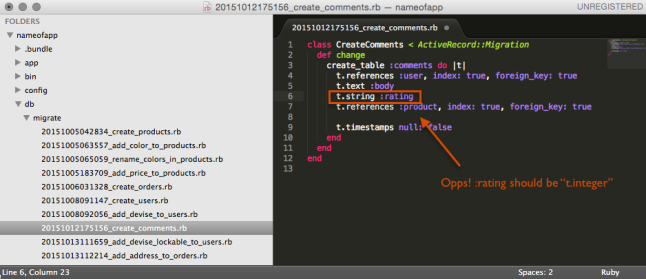db:rollback vs. db:migrate:down
It happens every once in a while - the database table is set up incorrectly in the migration file and you don’t realize it until later. Or maybe you simply need to edit the database table based on updated information. Read on:
Problem:

:rating is incorrectly identified in the comments database table as a string when it should be an integer
Solution A: db:rollback
To rollback the latest migration file, you can run:
$ rake db:rollback
However, this will only roll back the latest migration file. In our example, two more migration files were run after 20151012175156_create_comments.rb (the target migration file). Instead, use this command:
$ rake db:rollback STEP=3
STEP=3 rolls back the database 3 migration files to the target migration file that we desire. However, this will rollback the migrations that happened after the target migration as well. This can be good or bad - it is useful if you ran migration files after the target migration that you no longer need and want to undo. In this case, we won’t touch those other migration files.
Solution B: db:migrate:down version=
This is probably the better method to edit a target migration file, as it only rolls back the target migration file. Since we want to edit 20151012175156_create_comments.rb, run:
$ rake db:migrate:down version=20151012175156
where version is equal to the numbers (composed of date and time) located at the beginning of your migration file.
Whichever solution you choose, edit the migration file by changing “t.string” to “t.integer” and then run:
$ rake db:migrate
to update your database and finish. (In this example, Solution A will run the two migration files after the target migration file as well, while Solution B will only run the target migration file.)
Alternative Solution: run a new migration file
Instead of the potential anxiety that comes with having to edit history, you can run a new migration file to update the type cast of the :rating field in the comments table by dropping and re-adding the comments table. Run:
$ rails generate migration UpdateTypeCastOfRatings
This will create an empty migration file in which you can cleanly drop the old table from the database and add it again by copying and pasting the contents of the original target migration file to this new migration file. Your new migration file should look like this:
1
2
3
4
5
6
7
8
9
10
11
12
13
14
class UpdateTypeCastOfRatings < ActiveRecord::Migration
def change
drop_table :comments
create_table :comments do |t|
t.references :user, index: true, foreign_key: true
t.text :body
t.string :rating
t.string :integer
t.references :product, index: true, foreign_key: true
t.timestamps null: false
end
end
end
Make sure to run $ rake db:migrate to update your database.
If you don’t want to drop the entire table and create it again, you can use the change_column migration method on :rating. If interested, read more about this method.